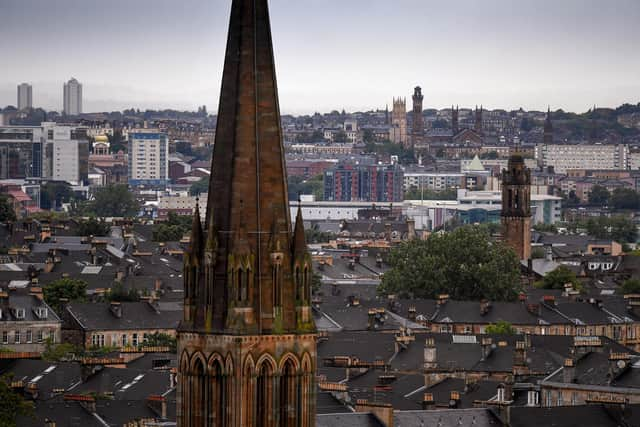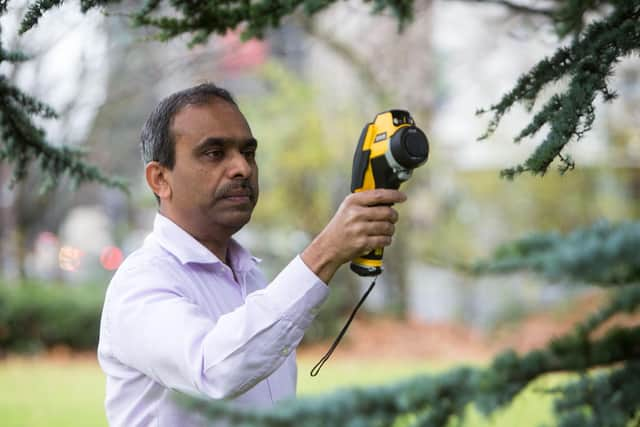How Scotland's cities are preparing for the worst of the climate crisis
But after a week in which record-breaking temperatures caused extensive disruption, it is clear the need for adaptation is more urgent than ever.
Authorities up and down the country are wrestling with the resilience issue. At a national level, projects are being steered under Scottish Government’s climate change adaptation programme, such as increased investment in flood warning systems.
Advertisement
Hide AdAdvertisement
Hide AdYet the real momentum is to be found at a regional level, where city officials are pursuing their own strategies to ready themselves for the unavoidable impacts of climate change.
In Glasgow, the host city of last autumn’s COP26 summit, it is no surprise the adaptation drive is underway at pace. The city and surrounding region is a largely urbanised sprawl, home to more than 1.8 million people. Faced with the myriad threats, authorities are banding together to broker solutions.
Climate Ready Clyde (CRC), an initiative funded by Glasgow City Council, neighbouring local authorities and other partners, has identified risks to infrastructure and coastal communities from flooding and coastal erosion. Flashpoints include sections of railway on the north of the Clyde and the Erskine bridge.
Indeed, the city council’s own adaptation plan allows for projections that the sea level in the Clyde basin may rise by up to 0.85 metres by 2100, with possible increases of 15 centimetres every decade thereafter.
But it is not just protecting the environment. Adaptation is about future-proofing the economy and delivering positive change for communities. One of CRC’s goals is helping the 140,000 people in the top 20 per cent of the Scottish Index of Multiple Deprivation, who live in areas that may experience heat hazards or flooding.


“I think we’re beginning to understand that adaptation isn’t just about sea defences,” explained Catherine Pearce, who leads the technical secretariat for CRC. “What we’ve tried to do is change that discourse and take a broader scope. It’s about societal, economic, as well as environmental risks.”
A key adaptation challenge facing Glasgow is what is known as the urban heat island effect, where built-up districts become significantly warmer than surrounding areas due to human activities. The implications are considerable, impacting everything from waste collections to land use planning.
Indeed, the built environment is at the centre of Glasgow’s strategy. The council plans to carry out a city-wide analysis by 2025 to identify the most vulnerable buildings and neighbourhoods.
Advertisement
Hide AdAdvertisement
Hide Ad

Action could include mandatory green roofs for certain new buildings and the requirement for flood risk assessments for basement conversions. The adaptation plan also proposes a programme to ‘de-pave’ the city by incentivising a reduction in impermeable surfacing.
“Our infrastructure has not been set up for the kind of increased temperatures we are going to see,” says Ms Pearce, the innovation manager at sustainability charity Sniffer and a member of the Edinburgh Climate Change Institute. “Our buildings can’t deal with these heatwaves, and we’re lacking the good quality open greenspace to help absorb those temperatures.”
Experts who have devoted their careers to the study of urban heat and cityscapes believe the change required is far reaching.
Rohinton Emmanuel, professor in sustainable design and construction at Glasgow Caledonian University, and a member of a World Meteorological Organisation expert team on urban and building climatology, said there be a focus on creating public squares and shaded commons.


“The urban heat risk mitigation will need green infrastructure, more blue infrastructure and a more 'outdoor living' orientation, as is currently the case in Mediterranean cities,” he explained.
“We have had a fabric first approach to our built environment so far, and this is appropriate in a heating-load dominated climate, but it is now time to plan for a more climate-resilient urban context.
“What is perhaps shocking during the current heatwave is how quickly and shatteringly the climate extreme records were broken. This is exacerbated by the urban heat island effect in cities. Cities will now need to prioritise heat island mitigation along with flood mitigation.”
None of this will come cheap. In Glasgow, the adaptation funding gap is £184m a year, but the council aims to close it by 2025. While some might baulk at such numbers, the cost of doing nothing is immeasurably greater. The damage from river, coastal, and surface water flooding alone amounts to £60m a year. CRC believes it could reach £290m by 2080.
Advertisement
Hide AdAdvertisement
Hide AdThe good news is the work is already underway. A notable example is the avenues initiative, which has seen hundreds of semi-mature trees planted in busy streets to mitigate heat and thermal sensation.
But what about the bigger picture? Is Scotland truly prepared for the climate crisis? The answer, according to the UK Climate Change Committee, is not yet.
Only four months ago, it completed its first independent assessment of the Scottish Government’s adaptation programme. Progress in delivering adaptation, the committee said, had “stalled”, with monitoring and evaluation “urgently needed”.
Its specific observations included the fact the majority of Scotland’s shoreline is not covered by management plans, and that data is not being collected on the number or location of new properties built in flood-risk areas. The latter concern is not hypothetical; only last August, severe flooding on a street in Glasgow’s Drumchapel area led to 50 homes being evacuated; all the properties were built in the early 2000s.
Michael Matheson, the cabinet secretary for net zero, energy and transport, stressed that “real progress” was being made, but accepted that “more needs to be done”.
Some believe the government should look to Glasgow for inspiration. “I think what the city is doing can be replicated and scaled elsewhere,” said Ms Pearce. “The leadership being shown in Glasgow can be great for Scotland.”
Comments
Want to join the conversation? Please or to comment on this article.
